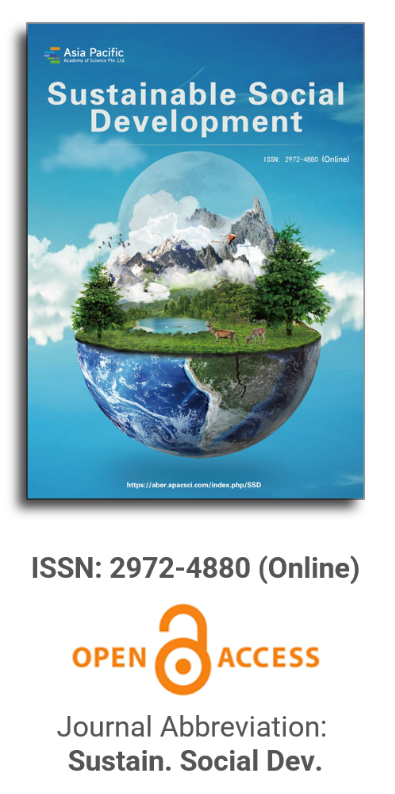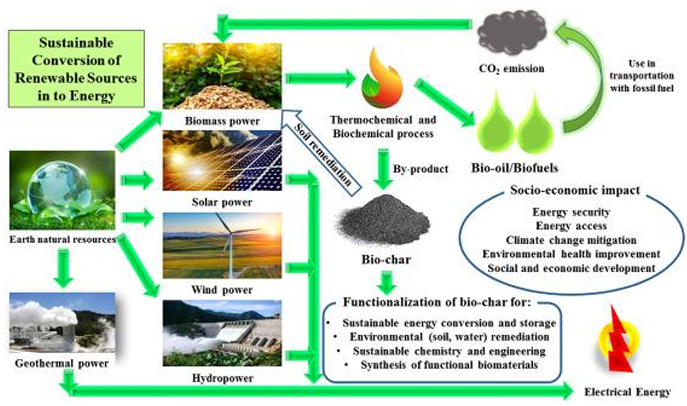
Asia Pacific Academy of Science Pte. Ltd. (APACSCI) specializes in international journal publishing. APACSCI adopts the open access publishing model and provides an important communication bridge for academic groups whose interest fields include engineering, technology, medicine, computer, mathematics, agriculture and forestry, and environment.

Geotechnical solutions for urban centers: Bridging engineering innovations with socio-economic development
Vol 1, Issue 3, 2023
Download PDF
Abstract
In the face of mounting geotechnical challenges within urban centers worldwide, the significance of engineering solutions extends beyond the immediate resolution of these issues to act as catalysts for socio-economic development. This paper examines specific geotechnical problems, such as soil instability and the underutilization of urban green spaces, and their direct impact on community health, safety, and the quality of urban life. With a focus on diverse international case studies, the research clarifies the reciprocal influence between geotechnical innovation and socio-economic advancements. It advocates for the integration of geotechnical practices into the broader scope of urban planning, detailing how cities can leverage these practices for sustainable growth and enhanced community well-being.
Keywords
References
- Profiroiu CM, Bodislav DA, Burlacu S, Rădulescu CV. Challenges of sustainable urban development in the context of population Growth. European Journal of Sustainable Development 2020; 9(3): 51. doi: 10.14207/ejsd.2020.v9n3p51
- Possehl GL. The Indus Civilization: A Contemporary Perspective. AltaMira Press; 2002. 288p.
- Fiorentino G, Quaranta G, Mylonakis G, et al. Seismic reassessment of the leaning tower of Pisa: Dynamic monitoring, site response, and SSI. Earthquake Spectra 2019; 35(2): 703–736. doi: 10.1193/021518EQS037M
- Görgen C. Everyday photography? Politicizing a ‘vernacular’ photo album of the San Francisco earthquake and fire of 1906. Interfaces: Image Texte Language 2020; 15(44): 29–51. doi: 10.4000/interfaces.1458
- Vilutiene T, Kalibatiene D, Hosseini MR, et al. Building information modeling (BIM) for structural engineering: A bibliometric analysis of the literature. Advances in Civil Engineering 2019; 2019: 5290690. doi: 10.1155/2019/5290690
- Ponzini D, Alawadi K. Transnational mobilities of the tallest building: Origins, mobilization and urban effects of Dubai’s Burj Khalifa. European Planning Studies 2022; 30(1): 141–159. doi: 10.1080/09654313.2021.1908233
- Firoozi AA, Guney Olgun C, Firoozi AA, Baghini MS. Fundamentals of soil stabilization. International Journal of Geo-Engineering 2017; 8: 26. doi: 10.1186/s40703-017-0064-9
- Chu J, Wu SF, Chen H, et al. New solutions to geotechnical challenges for coastal cities. Geotechnical Engineering 2021; 52(1): 61–66.
- Tokimatsu K, Tamura S, Suzuki H, Katsumata K. Building damage associated with geotechnical problems in the 2011 Tohoku Pacific Earthquake. Soils and Foundations 2012; 52(5): 956–974. doi: 10.1016/j.sandf.2012.11.014
- Bhattacharya S, Hyodo M, Goda K, et al. Liquefaction of soil in the Tokyo Bay area from the 2011 Tohoku (Japan) earthquake. Soil Dynamics and Earthquake Engineering 2011; 31(11): 1618–1628. doi: 10.1016/j.soildyn.2011.06.006
- Gonzalez-Navarro M, Turner MA. Subways and urban growth: Evidence from earth. Journal of Urban Economics 2018; 108(6): 85–106. doi: 10.1016/j.jue.2018.09.002
- Jin J, Kim D. Expansion of the subway network and spatial distribution of population and employment in the Seoul metropolitan area. Urban Studies 2018; 55(11): 2499–2521. doi: 10.1177/0042098017725476
- Mendes RM, de Andrade MR, Graminha CA, et al. Stability analysis on urban slopes: Case study of an anthropogenic-induced landslide in São José dos Campos, Brazil. Geotechnical and Geological Engineering 2018; 36(1): 599–610. doi: 10.1007/s10706-017-0303-z
- Smyth CG, Royle SA. Urban landslide hazards: Incidence and causative factors in Niterói, Rio de Janeiro State, Brazil. Applied Geography 2000; 20(2): 95–118. doi: 10.1016/S0143-6228(00)00004-7
- Dai L, Wörner R, van Rijswick HF. Rainproof cities in the Netherlands: Approaches in Dutch water governance to climate-adaptive urban planning. International Journal of Water Resources Development 2018; 34(4): 652–674. doi: 10.1080/07900627.2017.1372273
- Pot W. Anticipating the future in urban water management: An assessment of municipal investment decisions. Water Resources Management 2019; 33(4): 1297–1313. doi: 10.1007/s11269-019-2198-3
- Freddi F, Galasso C, Cremen G, et al. Innovations in earthquake risk reduction for resilience: Recent advances and challenges. International Journal of Disaster Risk Reduction 2021; 60: 102267. doi: 10.1016/j.ijdrr.2021.102267
- Mazel-Cabasse C. The case for not letting San Francisco collapse. In: Waiting for the Big One: Risk, Science, Experience, and Culture in Disaster Preparedness. Springer; 2019. pp. 159–215. doi: 10.1007/978-3-030-15289-5_5
- Wong NH, Yu C. Study of green areas and urban heat island in a tropical city. Habitat International 2005; 29(3): 547–558. doi: 10.1016/j.habitatint.2004.04.008
- Aflaki A, Mirnezhad M, Ghaffarianhoseini A, et al. Urban heat island mitigation strategies: A state-of-the-art review on Kuala Lumpur, Singapore and Hong Kong. Cities 2017; 62(7): 131–145. doi: 10.1016/j.cities.2016.09.003
- Altindal A, Karimzadeh S, Erberik MA, et al. A case study for probabilistic seismic risk assessment of earthquake-prone old urban centers. International Journal of Disaster Risk Reduction 2021; 61(1): 102376. doi: 10.1016/j.ijdrr.2021.102376
- Karataş L, Bayhan B. Damage assessment and restoration proposal following the 2023 Türkiye earthquakes: UNESCO World Heritage Site Diyarbakır City Walls, Türkiye. Heritage Science 2023; 11(1): 228. doi: 10.1186/s40494-023-01072-6
- Rutz K. Artificial islands versus natural reefs: The environmental cost of development in Dubai. International Journal of Islamic Architecture 2012; 1(2): 243–267. doi: 10.1386/ijia.1.2.243_1
- Al Hai N. 2D Elasto-Plastic Finite Element Analysis of Tunnels in Dubai, UAE [Master’s thesis]. American University of Sharjah; 2012.
- Mustapha S, Lu Y, Ng CT, Malinowski P. Sensor networks for structures health monitoring: Placement, implementations, and challenges—A review. Vibration 2021; 4(3): 551–585. doi: 10.3390/vibration4030033
- Choeycharoen P, Sornlar W, Wannagon A. A sustainable bottom ash-based alkali-activated materials and geopolymers synthesized by using activator solutions from industrial wastes. Journal of Building Engineering 2022; 54: 104659. doi: 10.1016/j.jobe.2022.104659
- Tang Y, Gao F, Wang C, et al. Vertical greenery system (VGS) renovation for sustainable arcade-housing: Building energy efficiency analysis based on digital twin. Sustainability 2023; 15(3): 2310. doi: 10.3390/su15032310
- Barns S. Re-engineering the city: Platform ecosystems and the capture of urban big data. Frontiers in Sustainable Cities 2020; 2: 32. doi: 10.3389/frsc.2020.00032
- Ikeagwuani CC, Nwonu DC. Emerging trends in expansive soil stabilisation: A review. Journal of Rock Mechanics and Geotechnical Engineering 2019; 11(2): 423–440. doi: 10.1016/j.jrmge.2018.08.013
- Rustiadi E, Pravitasari AE, Setiawan Y, et al. Impact of continuous Jakarta megacity urban expansion on the formation of the Jakarta-Bandung conurbation over the rice farm regions. Cities 2021; 111: 103000. doi: 10.1016/j.cities.2020.103000
- Arrogante-Funes P, Bruzón AG, Arrogante-Funes F, et al. Integration of vulnerability and hazard factors for landslide risk assessment. International Journal of Environmental Research and Public Health 2021; 18(22): 11987. doi: 10.3390/ijerph182211987
- Kandel N, Chungong S, Omaar A, Xing J. Health security capacities in the context of COVID-19 outbreak: An analysis of International Health Regulations annual report data from 182 countries. The Lancet 2020; 395(10229): 1047–1053. doi: 10.1016/S0140-6736(20)30553-5
- Chowdhury IN. Hazard-Consistent Ground Motions for Geotechnical Earthquake Engineering Analysis [PhD thesis]. North Carolina State University; 2022.
- Hanson HI, Eckberg E, Widenberg M, Olsson JA. Gardens’ contribution to people and urban green space. Urban Forestry & Urban Greening 2021; 63: 127198. doi: 10.1016/j.ufug.2021.127198
Supporting Agencies
Copyright (c) 2023 Ali Akbar Firoozi, Ali Asghar Firoozi
License URL: https://creativecommons.org/licenses/by/4.0/

This site is licensed under a Creative Commons Attribution 4.0 International License (CC BY 4.0).

Prof. Kittisak Jermsittiparsert
University of City Island, Cyprus





It is with deep regret that we announce the cancellation of the Forum on Sustainable Social Development & Computing and Artificial Intelligence, originally scheduled for June 15, 2025.

